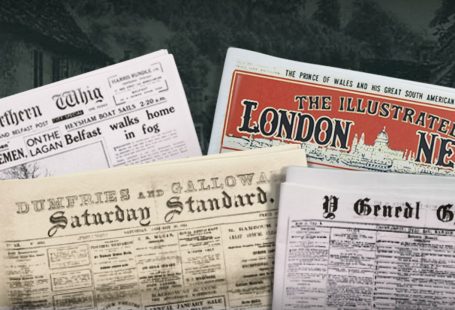This week we have added 102,572 new pages to The Archive, and we continue to add brand new and exciting titles to our collection.
This week sees the addition of new title The Queen to The Archive. The Queen, or to give it its full title, The Queen, The Ladies’ Newspaper and Court Chronicle was established as a society magazine by Samuel Beeton in 1861, and followed the goings-on of high society and the British aristocracy. We currently have the years 1887 to 1896 available to search.
We also have another new women’s title joining The Archive this week – the Women’s Gazette and Weekly News. Published in Manchester, this was a ‘journal devoted to the social and political position of women.’ Rounding off our trio of new titles is the Liverpool Standard and General Commercial Advertiser, for which we have available the year 1855.
Our existing specialist and regional titles have not been neglected this week either. We have a significant update to the Bristol Times and Mirror, with over 33,000 pages added, covering the years 1897 to 1911. We are delighted to have updated two of our early Labour publications – Clarion and the Labour Leader – as well as one of our religious titles, Witness (Edinburgh), and one of our sporting titles, the Football Post (Nottingham), displaying the astonishing range of interests represented in our Archive.
In this week’s blog we are going to take a look at society publication The Queen. The Queen features a plethora of stunning illustrations which depict the leading society ladies of the day, as well as advertisements selling the latest in high-end fashions. This makes it an invaluable resource for anybody interested in fashion history, as the clothes are detailed in the minutest manner.
For example, a page in a March 1887 edition depicts the dresses worn at Her Majesty’s drawing room a couple of weeks before. The Princess Sultana, daughter of Princess Malcom Khan, is shown wearing a ‘train and bodice of the richest pale blue faille Française,’ whilst the Misses Lethbridge wear ‘trains of primrose brocade, trimmed with pleatings and ruchings of tulle, and with silk pompons.’ Finally, Mrs Morrel is attired in a ‘train of heliotrope brocade,’ with a ‘petticoat of cream tulle, with pearl drops, ribbons and feathers.’
The Princess Sultana and Misses Lethbridge | The Queen | 12 March 1887
Readers of The Queen are not left out from this lavish style extravaganza. For example, a half-page advertisement in January 1886 for Peter Robinson of Oxford Street shows the range of evening dresses available for purchase. There is the ‘Eclipse,’ which is in a black Spanish lace net material, the ‘Cora,’ which is available in black, white and cream, and also the ‘Belle.’
However, far from simply focusing on the material and shallow, The Queen offers an intriguing insight into the changing lives of women in the late nineteenth century. An article in a June 1887 edition of the newspaper, which commemorates Queen Victoria’s fiftieth year on the throne, also celebrates women’s progress at Cambridge. Although the degree had yet to be granted to women, ‘this year the women have achieved an unexampled success.’
The success of the season has been gained by Miss A. F. Ramsay, a Girton student, who has gained a place in the first division of the Classical Tripos, in which no place has been given to any male competitor. That a woman should be the only candidate of the year deemed by examiners worthy of first-class honours is a fact of which the whole of the women students in the kingdom may well feel proud.
The same edition goes on to describe how it is ‘absolutely necessary that girls should be educated,’ and how ‘a great and thorough reform [is] needed in the management of girls’ boarding schools.’ Not only does the newspaper look at education for women, but also at the new avenues of work available for them: ‘Inquiry has lately been made in various quarters as to the possibility of shorthand writing becoming a remunerative employment for women.’
Of course, as the nineteenth century progressed into the twentieth, more and more women became engaged in this sort of employment. The Queen offers a fascinating and unique record of Victorian femininity – from the latest fashions, to the changes in the role of women, and their advancements in education and employment.
The Queen continued to be published until 1958 when it was bought by Jocelyn Stevens, and was renamed Queen. This publication represented the younger side of the British establishment and gave birth to pirate radio station Radio Caroline. It was merged with Harper’s Bazaar in 1970 to become Harper’s and Queen, and is still published today under the title Harper’s Bazaar.
NEW TITLES
Title |
Date range |
| The Queen | 1887, 1889-1891, 1893-1896 |
| Women’s Gazette & Weekly News | 1888-1889 |
| Liverpool Standard and General Commercial Advertiser | 1855 |
UPDATED TITLES
This week we have updated nine of our existing titles.
You can learn more about each of the titles we add to every week by clicking on their names. On each paper’s title page, you can read a FREE sample issue, learn more about our current holdings, and our plans for digitisation.
Title |
Date range |
| Bristol Times and Mirror | 1897, 1900-1907, 1911 |
| Witness (Edinburgh) | 1847 |
| Labour Leader | 1896, 1899, 1905-1907, 1917 |
| Reading Evening Post | 1989-1990 |
| Football Post (Nottingham) | 1973 |
| Harrow Observer | 1895-1898, 1906-1921 |
| Huddersfield Daily Examiner | 1871 |
| Express and Echo | 1866-1868 |
| Clarion | 1895 |
Register now and explore the Archive
You can keep up to date with all the latest additions by visiting the recently added page. You can even look ahead to see what we’re going to add tomorrow.









